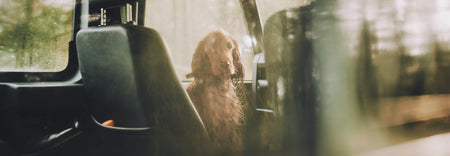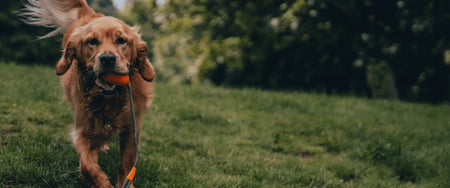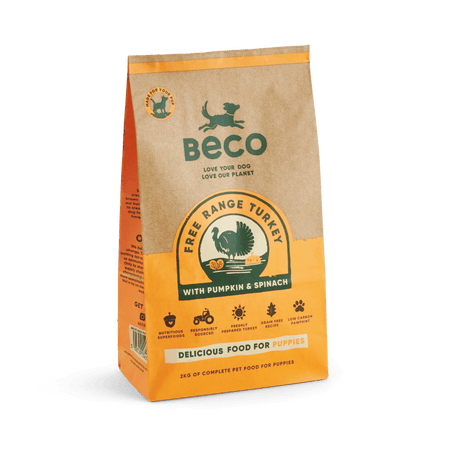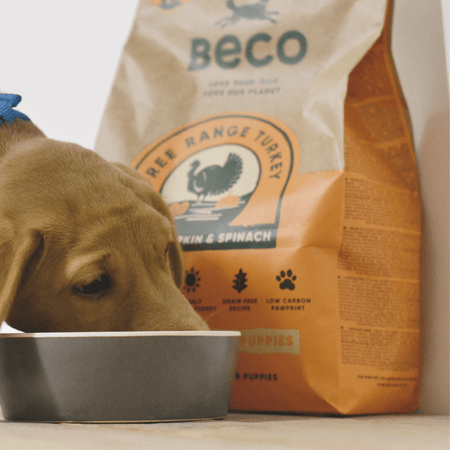There is nothing like the excitement of bringing a new puppy into your home. Days will be full of joy, watching them learn new things and becoming part of the family. We all want to make sure that our puppy has the best start in life, so we thought we’d share our top tips on what to buy for a new puppy and how to introduce them to your family; in other words, how to prepare for a new puppy.
A good place to start is to buy a puppy pack starter kit but there is a lot more to look into before your puppy is introduced into your life. Before we begin, and if you are short on time, here’s a quick and easy checklist of everything you need to prepare for a puppy:
Puppy pack
Healthy puppy food
Toys
Poo bags
Bed crate
Blankets
Collar and lead
Dog bowls and mats
A feeding area
A sleeping area
Register your puppy to a vet

What to Buy for a New Puppy?
To start, let’s go through the essential items to add to your list when you’re preparing for that little fur ball to pop through your door. If you’re planning to bring your puppy home in a car, please make sure they travel as safely as possible.
Toys
Firstly, we suggest buying a selection of strong dog toys. They need to be robust enough to endure your pup’s tugging and teething. Having a selection of toys to choose from makes sure that your puppy is entertained all day long. Importantly, they will take out their energy by chewing their toys instead of your shoes or cushions!
Poo Bags
When our puppy first goes out into nature, it’s exciting for the both of you. So, don’t let this bonding time be ruined by their waste stops. Choosing compostable dog poop bags gives you the opportunity to add to your home compost heap, whilst also still being durable and strong, so there’ll be no mess whilst clearing up.
Bedding
Your pup needs somewhere comfortable to sleep in and a place to feel safe and protected. So buying the right bed or crate is important. It’s best to get one that they can grow into, so make sure you’re factoring in how much they typically grow depending on their breed. After you’ve bought your bed, fill it with blankets. These are ideal for ensuring that your pup feels cosy when they rest.
Collar and Lead
Getting a good-fitting collar and lead is important for the safety of your puppy. You should also get a tag just in case they get lost.
Dog Bowls and Mats
Once you’ve bought a dog bowl for your pup, you should consider buying a mat, too. Mealtimes can be messy, so having a mat will make clearing the food that overflows your excited puppy’s bowl both quick and easy.
However, your first port of call when preparing for your puppy should probably be purchasing a puppy pack.
What’s in a Puppy Pack?
Puppy food
60 eco-friendly dog poop bags to make clearing up after your pup an easier experience
Two toys. The tough rubber chew toy is perfect for their chewing instincts and teething, whereas the soft toy is perfect for snuggling into after a tiring day of adventures.

What Food Should You Get for a New Puppy?
It’s important that your puppy starts its life eating the healthiest puppy food possible so that they grow big and strong. But, how can you make sure that the food they eat provides all the best nutritional ingredients? Here’s what to look out for when buying puppy food:
- Protein is essential for their muscle development. Make sure the food that you buy has a good protein source, like Turkey. The amino acids support every cell, optimising your puppy’s health.
- Fruit and veg. Your puppy needs an abundance of vitamins and minerals to help its immune system, coat and overall health. These are found in a variety of vegetables and fruits.
- Puppies need fibre for good digestion. This can be found in fruit and vegetables like pumpkin, but also pulses and legumes.
- Choose grain-free. We recommend grain-free puppy food as grain can be difficult for puppies to digest. Some puppies also have intolerances to grain which affects their stomach and digestion, skin and fur. Choosing grain-free also means that your puppy has food that is full of healthy, delicious vegetables and pulses.
- Puppy-specific. Choose food that has been specially created for puppies. The kibble will be smaller and therefore easier for your pup to chew and digest. It also usually contains extra glucosamine for extra muscle support.
It’s not just what you feed your puppy but how often and how much. We’ve covered this topic in one of our previous blogs, which you can find here. In short – puppies’ stomachs are small and can be sensitive, so you need to feed them small and often, rather than a couple of big meals a day. All different breed vary, but here is a rough guide:
| AGE | HOW OFTEN | WHICH FOOD |
|---|---|---|
| 5 - 12 weeks | 3 or 4 times a day | small portiosn of puppy food |
| 4 -6 months | 3 times a day | puppy food |
| 6 - 8 months | 2 times a day | puppy food |
| 12 -13 months | 2 times a day | adult dog food |
How to Prepare Your Home for a Puppy?
When preparing your home for a new puppy, one of the first things you want to focus on is setting up an eating area.
1. Eating Area
This place should stay the same to make your puppy feel as comfortable as possible. Set up your mat and bowl in a quiet corner and make sure to store their food somewhere that they cannot get into.
2. Sleeping Area
Your pup should have an area to sleep in. This should be somewhere away from where they eat. This, too, should be both quiet and private. Fill the bed or crate with toys and blankets so that they are warm and comfortable.
Make sure you are giving them sufficient sleep. Whilst they’re undoubtedly the cutest, there’s a chance certain family members may want to interact with them too much. Like a baby, they need lots of rest and sleep time and this will help them develop a calmer temperament.
3. Set Up Boundaries
If you have areas that you want your puppy to keep away from, installing baby gates into your house sets up boundaries. Make sure that you are consistent with these boundaries to minimise confusion.
Likewise, be consistent with what you allow your puppy to do immediately and in the future. You may want them on your sofa as a puppy, but will you want their full-size version sitting next to you?
4. Move Hazardous Objects Out of Reach
Check your house and garden for sharp or hazardous household objects and make sure that they are out of reach. The same goes for poisonous cleaning products and electric cables.
Your puppy will be curious about everything in their new home, so make sure they won’t go chewing anything that might harm them.
5. “Dog Proof” Your Garden/Outdoor Space
For your puppy to be able to play outside, you must make sure that your garden is sectioned off. Your inquisitive puppy will want to explore anything and everything, so check for any holes in fences or hedges. Also, have a look out for any poisonous plants like daffodils, geraniums or rhubarb.
Final Thoughts on Preparing for a Puppy
After you have prepared your house and bought these puppy-friendly items, your family should be ready for their newest member. In terms of their behaviour, remember to be patient: this is an overwhelming time for a new pup and they might be easily scared or confused. These puppy tips should make sure that you have less time worrying about what your puppy needs, so that your days will be filled with fun, laughter and puppy cuddles.













